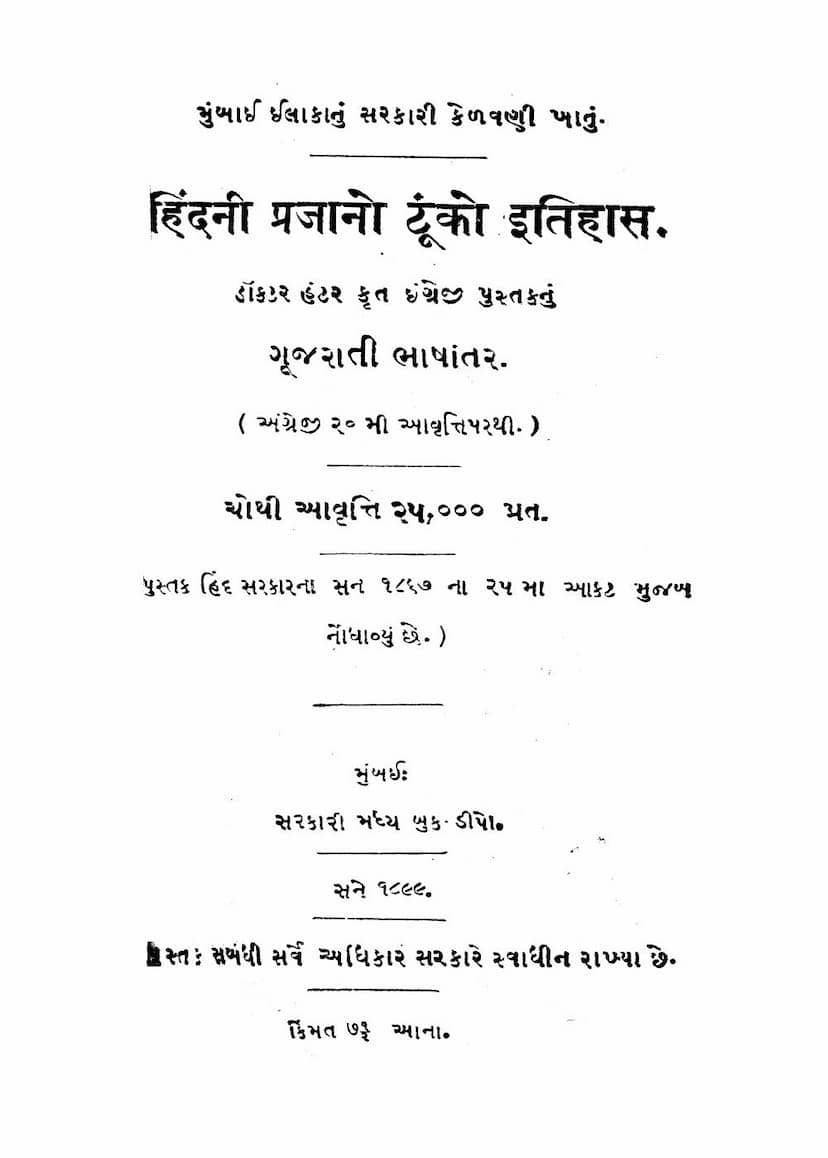Hindni Prajano Tunko Itihas
Added to library: September 1, 2025

Summary
Based on the provided Jain text, here is a comprehensive summary in English:
Book Title: Hindni Prajano Tunko Itihas (A Brief History of the Peoples of India) Author(s): W. W. Hunter, Unknown Publisher: Education Society Catalog Link: https://jainqq.org/explore/032729/1
Summary:
This book, "Hindni Prajano Tunko Itihas," is a Gujarati translation of Dr. W. W. Hunter's English work on the history of the Indian people. It aims to present the growth of the Indian population, their contributions to the world's betterment, and their experiences with other civilizations. The author criticizes the common tendency in English historical accounts to quickly cover the first two thousand years of Indian history, thereby presenting an incomplete picture. Hunter emphasizes that such a truncated approach is neither beneficial for Europeans nor for Indians and that it fails to capture the true essence of India's history. He strives to present a more comprehensive and factual historical narrative based on original sources, the result of twenty years of diligent research.
The book's preface (prastavana) highlights the author's intention to explain how the Aryan people, originating from Central Asia, settled in India and how the fertile land of India allowed this advanced civilization to develop language, knowledge, and religion. It touches upon the challenges faced by these people in the face of nature, their societal structure, and the integration of religious and societal aspects that bound them together, though not always creating a unified national identity.
The catalog link and the initial pages reveal the book's structure and content. It is a detailed historical account of India, divided into numerous chapters (Prakaran) covering a vast timeline and various aspects of Indian history and society.
Key Themes and Chapters:
The table of contents (Anukramanika) provides a detailed roadmap of the book's extensive coverage:
- Chapter 1: Description of the Country (Desh nu Varnan): Discusses the geographical position and size of India, its four major regions, including the Himalayan region and its rivers (Sindhu, Sutlej, Brahmputra, Ganga, Yamuna), the riverine plains, the Deccan plateau, and Burma. It also touches upon the climate, flora, and fauna.
- Chapter 2: The People (Lok): Provides a general overview of the population, statistics of British and native India, population density, scarcity of large cities, distribution of people, agricultural practices, social customs, and the distinction between two primary groups of people before historical times.
- Chapter 3: The Indigenous/Non-Aryan Peoples (Anarya Lok): Focuses on the original inhabitants of India, their description in ancient texts, and their current status. It discusses various tribal groups in different regions and their societal structures, rituals, and characteristics.
- Chapter 4: The Aryan Peoples in India (HINDMA ARYA LOK): Delves into the origins of the Aryans, their migration into India, their societal development, Vedic literature, the formation of the caste system, the pantheon of Vedic deities, philosophical concepts, literature, and the great epics of Mahabharata and Ramayana.
- Chapter 5: Buddhism in India (HINDMA BUDDHA DHARMA): Covers the rise of Buddhism, the life and teachings of Gautama Buddha, the spread of Buddhism, Ashoka's conversion and patronage, the councils, the rivalry between Buddhism and Brahmanism, and the eventual decline of Buddhism in India. It also notes that Jains are considered followers of ancient Buddhist paths and discusses Buddhism's influence on Hinduism.
- Chapter 6: The Greeks in India (HINDMA GREEK LOK): Discusses the early Greek accounts of India and Alexander the Great's campaigns in the Punjab and Sindh, and the Greek influence that followed.
- Chapters 7-14: Cover subsequent historical periods and invasions, including the Sakas, the growth of Hinduism, the arrival of Muslim conquerors, the Mughal dynasty, the Marathas, the early European settlements, and the establishment of British rule in India. These chapters detail various dynasties, rulers, battles, administrative policies, and social reforms introduced during these eras.
- Chapter 15: The Sepoy Mutiny of 1857 (Sane 1857 no Sipaiyo no Bal): Details the causes, events, and spread of the Sepoy Mutiny.
- Chapter 16: India under British Crown Rule (British Rajgadi na Tabama Hind 1858-1892): Chronicles the administrative and political developments under direct British rule, including significant events, policies, and the tenure of various Viceroys.
Key Arguments and Perspectives:
- Critique of Existing Histories: Hunter critiques the superficiality of earlier historical accounts that neglected the early centuries of Indian history.
- Focus on Socio-Cultural and Religious Development: The book places significant emphasis not just on political events but also on the evolution of Indian society, culture, language, and religions, including the significant periods of Buddhism and the resurgence of Hinduism.
- Impact of Migrations and Invasions: It traces the influence of various migrations, including those of the Aryans and later invaders like the Greeks, Shakas, and Muslims, on the Indian subcontinent.
- British Rule: The later chapters focus on the establishment and consolidation of British rule, detailing the administrative structure, the roles of various Viceroys, and the impact of British policies on India.
- Statistical Data: The book incorporates statistical data, particularly concerning population figures from the 1891 census, to illustrate the demographic landscape of India.
In essence, "Hindni Prajano Tunko Itihas" aims to be a comprehensive and accessible historical overview of India, acknowledging its diverse origins, cultural achievements, and the complex interplay of various civilizations and political powers that shaped its destiny. It emphasizes factual narration and a deep dive into the sources to provide a valuable resource for understanding the Indian past.